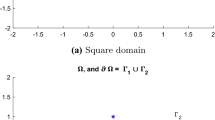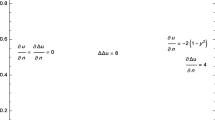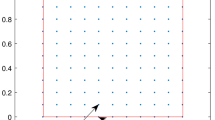Abstract
In this paper, a suitable method is presented to treat the partial derivative equations, especially the Laplace equation having the Robin boundary conditions. These equations come from classical physics, especially the branch of thermodynamics, and have an efficient role in the field of heat and temperature. Our motivation is to reset a harmonic data obtained from Robin’s conditions in the arbitrary plane domain particularly on its boundaries. The applied method is a nodal Hermite meshless collocation technique at which it is formed of radial basis functions to get out the shape functions which is the key to construct the local bases in the neighborhoods of the nodal points. Moreover, by taking into consideration the Hermite interpolation technique, we can impose the boundary conditions directly, the named technique is called “MRPHI,” meshless radial point Hermite interpolation, and it is done on some examples so that trustworthy results are obtained.







Similar content being viewed by others
References
Mastascusa EJ (1988) Computer-assisted network and system analysis. Wiley, New York
Cucinotta A, Selleri S, Vincetti L, Zoboli M (2002) Holey fiber analysis through the finite-element method. IEEE Photonics Technol Lett 14(11):1530–1532
Hayashi M, Jin M, Thipprakmas S, Murakawa M, Hung J-C, Tsai Y-C, Hung C-H (2003) Simulation of ultrasonic-vibration drawing using the finite element method (fem). J Mater Process Technol 140(1–3):30–35
Dehghan M, Abbaszadeh M (2017) A finite element method for the numerical solution of rayleigh-stokes problem for a heated generalized second grade fluid with fractional derivatives. Eng Comput 33(3):587–605
Lages EN, Paulino GH, Menezes IF, Silva RR (1999) Nonlinear finite element analysis using an object-oriented philosophy-application to beam elements and to the cosserat continuum. Eng Comput 15(1):73–89
Kazem S, Dehghan M (2019) Semi-analytical solution for time-fractional diffusion equation based on finite difference method of lines (mol). Eng Comput 35(1):229–241
Li P-W, Fan C-M (2017) Generalized finite difference method for two-dimensional shallow water equations. Eng Anal Bound Elem 80:58–71
Parand K, Abbasbandy S, Kazem S, Rezaei A (2011) An improved numerical method for a class of astrophysics problems based on radial basis functions. Phys Scr 83(1):015011
Kansa EJ, Aldredge RC, Ling L (2009) Numerical simulation of two-dimensional combustion using mesh-free methods. Eng Anal Bound Elem 33(7):940–950
Abbasbandy S, Ghehsareh HR, Alhuthali MS, Alsulami HH (2014) Comparison of meshless local weak and strong forms based on particular solutions for a non-classical 2-d diffusion model. Eng Anal Bound Elem 39:121–128
Abbasbandy S, Sladek V, Shirzadi A, Sladek J (2011) Numerical simulations for coupled pair of diffusion equations by mlpg method. CMES: Comput Model Eng Sci 71(1):15–38
Mohammadi V, Mirzaei D, Dehghan M (2019) Numerical simulation and error estimation of the time-dependent allen-cahn equation on surfaces with radial basis functions. J Sci Comput 79(1):493–516
Hosseini VR, Shivanian E, Chen W (2016) Local radial point interpolation (mlrpi) method for solving time fractional diffusion-wave equation with damping. J Comput Phys 312:307–332
Hosseini VR, Shivanian E, Chen W (2015) Local integration of 2-d fractional telegraph equation via local radial point interpolant approximation. Eur Phy J Plus 130(2):33
Shivanian E, Fatahi H (2019) Analysis of meshless local radial point interpolant on a model in population dynamics. Comput Methods Differ Equ 7(2):276–288
El Seblani Y, Shivanian E (2019) Boundary value identification of inverse cauchy problems in arbitrary plane domain through meshless radial point hermite interpolation. Eng Comput. https://doi.org/10.1007/s00366-019-00755-8
Dehghan M, Abbaszadeh M (2018) The simulation of some chemotactic bacteria patterns in liquid medium which arises in tumor growth with blow-up phenomena via a generalized smoothed particle hydrodynamics (GSPH) method. Eng Comput 35:875–892. https://doi.org/10.1007/s00366-018-0638-y
Adami S, Hu X, Adams NA (2012) A generalized wall boundary condition for smoothed particle hydrodynamics. J Comput Phys 231(21):7057–7075
Liu WK, Jun S, Zhang YF (1995) Reproducing kernel particle methods. Int J Numer Meth Fluids 20(8–9):1081–1106
Nayroles B, Touzot G, Villon P (1992) Generalizing the finite element method: diffuse approximation and diffuse elements. Comput Mech 10(5):307–318
Belytschko T, Lu YY, Gu L (1994) Element-free galerkin methods. Int J Numer Meth Eng 37(2):229–256
Fasino D, Inglese G (1999) An inverse robin problem for laplace’s equation: theoretical results and numerical methods. Inverse Prob 15(1):41
Lanzani L, Shen Z (2005) On the Robin boundary condition for Laplace’s equation in Lipschitz domains. Commun Partial Differ Equ 29:1–2, 91–109. https://doi.org/10.1081/PDE-120028845
Shivanian E, Jafarabadi A (2017) Inverse cauchy problem of annulus domains in the framework of spectral meshless radial point interpolation. Eng Comput 33(3):431–442
Delvare F, Cimetière A, Pons F (2002) An iterative boundary element method for cauchy inverse problems. Comput Mech 28(3–4):291–302
Yang JP, Guan P-C, Fan C-M (2016) Weighted reproducing kernel collocation method and error analysis for inverse cauchy problems. Int J Appl Mech 8(03):1650030
Liu C-S (2008) A modified collocation trefftz method for the inverse cauchy problem of laplace equation. Eng Anal Bound Elem 32(9):778–785
Jourhmane M, Nachaoui A (1999) An alternating method for an inverse cauchy problem. Numer Algorithms 21(1–4):247
Chakib A, Nachaoui A (2006) Convergence analysis for finite element approximation to an inverse cauchy problem. Inverse Prob 22(4):1191
Chen W, Fu Z-J (2009) Boundary particle method for inverse cauchy problems of inhomogeneous helmholtz equations. J Mar Sci Technol 17(3):157–163
Bourgeois L (2005) A mixed formulation of quasi-reversibility to solve the cauchy problem for laplace’s equation. Inverse Prob 21(3):1087
Fasshauer GE (2007) Meshfree approximation methods with MATLAB. World Scientific Publishing, Singapore
Mohammadzadeh R, Lakestani M, Dehghan M (2014) Collocation method for the numerical solutions of lane-emden type equations using cubic hermite spline functions. Math Methods Appl Sci 37(9):1303–1717
Franke C, Schaback R (1998) Solving partial differential equations by collocation using radial basis functions. Appl Math Comput 93(1):73–82
Sharan M, Kansa E, Gupta S (1997) Application of the multiquadric method for numerical solution of elliptic partial differential equations. Appl Math Comput 84(2–3):275–302
Kansa EJ (1990) Multiquadrics–a scattered data approximation scheme with applications to computational fluid-dynamics–i surface approximations and partial derivative estimates. Comput Math Appl 19(8–9):127–145
Wendland H (1998) Error estimates for interpolation by compactly supported radial basis functions of minimal degree. J Approx Theory 93(2):258–272
Powell MJ (1992) The theory of radial basis function approximation in 1990. In: Light W (ed) Advances in numerical analysis, vol I. Clarendon Press, Oxford, pp 105–210
Baratchart L, Bourgeois L, Leblond J (2016) Uniqueness results for inverse robin problems with bounded coefficient. J Funct Anal 270(7):2508–2542
Sincich E (2007) Lipschitz stability for the inverse robin problem. Inverse Prob 23(3):1311
Acknowledgements
The authors are grateful to anonymous reviewers for carefully reading this paper and for their valuable comments and suggestions, which have improved the paper.
Author information
Authors and Affiliations
Corresponding author
Additional information
Publisher's Note
Springer Nature remains neutral with regard to jurisdictional claims in published maps and institutional affiliations.
Rights and permissions
About this article
Cite this article
Seblani, Y.E., Shivanian, E. Data discovering of inverse Robin boundary conditions problem in arbitrary connected domain through meshless radial point Hermite interpolation. Engineering with Computers 37, 1821–1833 (2021). https://doi.org/10.1007/s00366-019-00915-w
Received:
Accepted:
Published:
Issue Date:
DOI: https://doi.org/10.1007/s00366-019-00915-w




